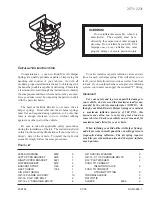
Speed letter
Q = up to 100 mph, 160 km/h
R = up to 106 mph, 170 km/h
S = up to 112 mph, 180 km/h
T = up to 118 mph, 190 km/h
H = up to 131 mph, 210 km/h
V = up to 150 mph, 240 km/h
W = up to 167 mph, 270 km/h
Y = up to 186 mph, 300 km/h
Tire Identification Number
DOT code: DOT xxxx xxx 2116
xxxx: manufacturer code for the tire brand
xxx: tire size and tire design
2116: tire age
Tires with DOT codes meet the guidelines of
the U.S. Department of Transportation.
Tire age
DOT … 2116: the tire was manufactured in the
21st week of 2016.
Recommendation
Regardless of wear and tear, replace tires at
least every 6 years.
Uniform Tire Quality Grading
Quality grades can be found where applicable
on the tire sidewall between tread shoulder
and maximum section width.
E.g.: Treadwear 200; Traction AA; Tempera‐
ture A
DOT Quality Grades
Treadwear
Traction AA A B C
Temperature A B C
All passenger vehicle tires must conform to
Federal Safety Requirements in addition to
these grades.
Treadwear
The treadwear grade is a comparative rating
based on the wear rate of the tire when tested
under controlled conditions on a specified gov‐
ernment test course. E.g., a tire graded 150
would wear one and one-half, 1 g, times as well
on the government course as a tire graded
100. The relative performance of tires depends
upon the actual conditions of their use, how‐
ever, and may depart significantly from the
norm due to variations in driving habits, service
practices and differences in road characteris‐
tics and climate.
Traction
The traction grades, from highest to lowest,
are AA, A, B, and C.
Those grades represent the tire's ability to
stop on wet pavement as measured under
controlled conditions on specified government
test surfaces of asphalt and concrete. A tire
marked C may have poor traction performance.
The traction grade assigned to this tire is
based on straight-ahead braking traction tests,
and does not include acceleration, cornering,
hydroplaning, or peak traction characteristics.
Temperature
The temperature grades are A, the highest, B,
and C, representing the tire's resistance to the
generation of heat and its ability to dissipate
heat when tested under controlled conditions
on a specified indoor laboratory test wheel.
Sustained high temperature can cause the ma‐
terial of the tire to degenerate and reduce tire
life, and excessive temperature can lead to
sudden tire failure. The grade C corresponds
to a level of performance which all passenger
vehicle tires must meet under the Federal Mo‐
tor Vehicle Safety Standard No. 109. Grades
Band A represent higher levels of performance
on the laboratory test wheel than the minimum
required by law.
Seite 224
Mobility
Wheels and tires
224
Online Edition for Part no. 01 40 2 973 026 - VI/16
Summary of Contents for X5 2017
Page 2: ......
Page 12: ...Online Edition for Part no 01 40 2 973 026 VI 16 ...
Page 32: ...Online Edition for Part no 01 40 2 973 026 VI 16 ...
Page 191: ...Storage compartments Controls 191 Online Edition for Part no 01 40 2 973 026 VI 16 ...
Page 192: ...Online Edition for Part no 01 40 2 973 026 VI 16 ...
Page 208: ...Online Edition for Part no 01 40 2 973 026 VI 16 ...
Page 263: ...Care Mobility 263 Online Edition for Part no 01 40 2 973 026 VI 16 ...
Page 264: ...Online Edition for Part no 01 40 2 973 026 VI 16 ...
Page 280: ......
















































